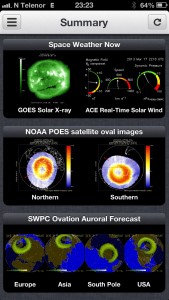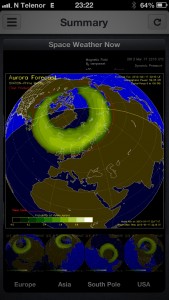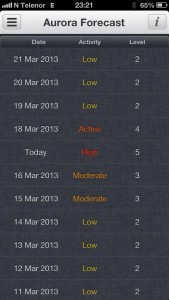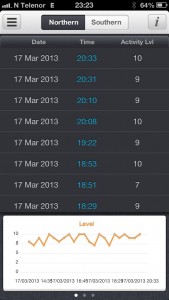The video below is what we saw set to music
Apparently there is no need to go to the Arctic – you can see them in Scotland and Northern England
The Northern Lights – Aurora Borealis
We went to Arctic Norway (which is the farthest North that we have ever been) to try and see this strange phenomenon.
- 1st day was very cloudy with not a lot of action,
- 2nd day there was a lot of action with a fair bit of cloud cover,
- last day what can I say, easier to look at the pictures and you will easily see which day was which!
The forecast for activity was very good as you can see from the screen shots below of an Aurora alert app and the sky was also clearing but neither of these are a cast iron guarantee.
On the last day we waited for a couple of hours with a clear sky but no aurora, eventually we saw a bit of colour over the horizon, which was actually so faint our driver only saw it after photographing the area. Our driver the decided to change our position so moved around the hill a bit and all of a sudden it started. Luckily we were next to an abandoned tourist craft market and had the silhouette of the Lavu tents. 5 minutes after we left that spot it all happened again and similarly on the way home. What a night, especially as it was our last night. Interestingly enough this was the cheapest tour that we did in Tromso and Roger from Aurora was the best guide and this was the best tour!
Believe me this is something that should be on everyone’s bucket list!
4 interesting facts about the Aurora
- You cannot “chase” the Aurora – only chase clear sky to see it, as someone 100-200km away will be looking at exactly the same Aurora as you and from the same angle as it is 100km up in the sky!
- Aurora comes in several colours not just green but pink, purple, orange and white.
- Best time is generally between 9-11pm but during high activity in the dark months it has been seen as early as 2-3pmand as late as 5am.
- You cannot see the full extent of the Aurora with a naked eye you to need to record it with a camera to get the full effect although it is certainly bright enough to read a paper by at the dead of night
Here is an in depth explanation:
An aurora is a natural light display in the sky particularly in the Arctic and Antarctic regions, caused by the collision of energetic charged particles with atoms in the high altitude atmosphere. The charged particles originate in the magnetosphere and solar wind and, on Earth, are directed by the Earth’s magnetic field into the atmosphere. Most aurorae occur in a band known as the auroral zone, which is typically 3° to 6° in latitudinal extent and generally between 10° to 20° from the magnetic pole. During a geomagnetic storm, the auroral zone can expand to lower latitudes.
Aurora is classified as discrete or diffuse:
The diffuse aurora is a featureless glow in the sky that may not be visible to the naked eye, even on a dark night. It defines the extent of the auroral zone.
The discrete aurorae are sharply defined features within the diffuse aurora. They display magnetic field lines or curtains like structures that can change in seconds or glow unchanged for hours. They vary in brightness from just barely visible to the naked eye, to bright enough to read a newspaper by at night most often in a fluorescent green. Discrete aurorae are usually seen only in the night sky, because they are not as bright as the sunlit sky.
The Northern Lights – Aurora Borealis
We went to Arctic Norway (which is the farthest north that we have ever been) to try to see this strange phenomenon. Please click to see if we were successful.




